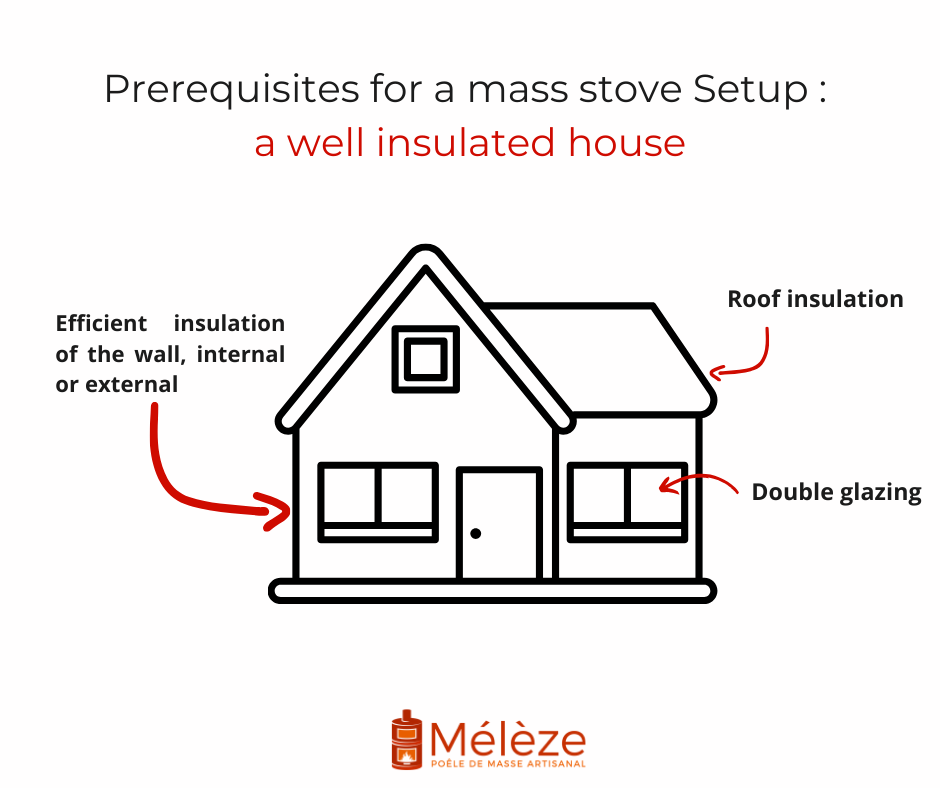How it works
How operate our fireplaces ?
Heat the entire house with a mass stove ?
We love firewood because it links us to our ancestors.
When we are close to a campfire, there is no risk to get attacked by wolves or bears. We can let our guard down, relax and enjoy the moment by looking vaguely at the dancing flames
That’s it for poetry. Now let’s get into the masonry stove’s functioning!
Good reading!
Heating by convection vs radiation
Limits of the traditional stove or insert
Wood stoves or traditional inserts have drowbacks : dry warmth, hot air bubble, absence of thermal inertia.
The hot air bubble is created at the touch of the stove / insert and produce convection movements
This hot air does no mix with cold air. Hot air being lighter than cold air, it’s going to get stuck to the ceiling and if it can, get to the higher floor and overheat it.
If the bubble can't go up, it’s going to get stuck around the stove and we can have the weird feeling to have an overheated head and cold at the back or have cold feet and hot head.
Benefits and drowbacks of convection heating

Air get warm fast. It’s easy to get heat with a convection wood stove*: you start a fire and 30 minutes later, it’s warm around the stove.
However, it’s harder to spread this warmth all around the house : the best option is often to put an electrical ventilation system to push the air toward the colder rooms.
As we often have drowbacks to the benefits: it heats fast = it cools fast ça chauffe vite = ça refroidit vite.
The biggest drowback of this heating system is that you have to maintain the fire all day and add firewood every hour. That’s what we call « to be at the stove’s bedside ».
We will now explain why the masonry stove is:
- Simple
- Comfortable
- Clean
- Thrifty
Why is it so easy to heat with a mass stove?
What caracterize the mass stove is… its mass.
It doesn’t heat the house with the fire itself but with… the mass!
It’s indirect heating: the firebrick warms the house thanks to the heat it has accumulated during the fire.
Heavier is the fireplace, more the heat restitution will be extended. The choice of a very heavy stove is adapted to house that have low inertia (straw walls by exemple) or a lot of inertia (stone walls by exemple) with no insulation.
It’s easy to make a 2 hour fire to load the mass stove with heat, that is going to be diffused during 12 hours with a soft warmth.
- No overheat during the fire
- No monitoring of the fire
- No night watch!
More simplicity?
Mélèze fireplaces are part of a very selective club that offers single loading: put all the wood load at once in the hearth, light at the top and it’s done!
No need to make three to five little loads like Tulikivi, NunnaUuni or Nordpeis fireplaces.
Why is it so comfortable to heat with a mass stove?
There is only three ways to convey heat : convection, conduction and radiation
The slow restitution mass stove uses the infrared radiation. Just like the sun!
Beyond telling you that putting a mass stove in your house is like putting a little sun, it helps to understand how it heats: everything that is exposed to the radiation is heated, in other words, the fireplace heats everything it sees.
A wall in the way radiation’s way is making shadow, the nature of this wall defines the behaviour
If it's a heavy supporting wall, it absorb the radiation, heats up and transmit a part of the heat.
If it’s a placo partition, it will transmit less.
If it’s a brick partition, it will transmit better
Nevertheless, these are weak transfers. The final result of the heating is linked directly to the house insulation .
Beside the partition behavior that favors more or less the heat transfer, it’s the insulation’s efficiency all around that stops this heat from exiting the house and sets the final result
It’s all the same with the floors: we’re frequently asked the question of the floors insulation. If you put 5cm of insulator, will the heat go through the floor ?
The answer is always yes. But if you put 35cm of insulator in the roof, the temperature at the floor will be closer than the one at the ground floor. If there’s 20cm of insulator on the roof, there will be more heat exiting through the roof than there would be arriving from the floor, so the temperature would be lower at the floor.
So… no limit with the mass stove ?
You see at what distance the sun can heat us.
Of course, the power can’t be compared, but the transport mode is the same.
The house’s size is then not an issue. The 2 questions that we have to answer to evaluate the result are the following :
1- 1 – Can I place the stove so it radiates through all the living space and on the walls and floors of the night space ? et sur les cloisons et planchers des espaces de nuit ?
2- The bigger the house, the better the insulation have to be ?
A well positioned mass stove + an efficient insulation = a house well heated !

Why a mass stove is economic ?
The type of fuel choice : the firewood is a cheap fuel. A lot of us knows someone who has access to wood, or simply lives near a forest.
Then, the system performances: if we look at a pellet stove or a wood boiler, it shows the same level of efficiency, close to 90 %. We could think « great, it’s the best ! ». Well, we are better. rendements, proches de 90 %. On pourrait dire « formidable, on est dans les meilleurs » et bien non, on est encore meilleur.
Regarding the pellet stove: without discussing the price of a bag of pellet, it heats by convection, this air bubble that has trouble to warm all the house. You then have a poorly distributed heat around the house, that forces you to find other ways to heat other rooms.
For the pellet or wood boiler: the price of the fuel is high for the first, and the investment is heavy for the second. But in any case we are still better for the heat distribution.
With a boiler, the heat is produced in a specific room, the pipes goes through the walls to get in the radiators. Everything have to be insulated, and the losses in the system are important.
With a slow heat release stove, the warmth is brought directly where you need it the most: at the heart of the living room. It’s the space that must be the most comfortable, with a few extra degrees closer to the stove next to the couch. As you get further away from it, the temperature gently goes down in an unnoticeable way. Once you’re in your bedroom, there’s still 17°c or 18°c, perfect for a good night’s sleep!
Except in the case of a teenager: an auxiliary heater system might be necessary in a teen's room, as they often live on their bed. Bring the 2 or 3 degrees missing implies a very low additional consumption, because the base is brought by the fireplace.
What is to remember with this heating system: the warmth is distributed in the house. Of course, it’s warmer close to the stove, but the auxiliary heater to bring in the colder rooms represent a small amount of energy.
Why is it sustainable and environmentally friendly?
We could make a whole chapter on this matter!
The manufacturing technique of the fireplace
We talked about the high efficiency, which is a direct consequence on the environment. If we transform correctly the wood into heat, there is no unburnt waste, products of a poor combustion that exist typically when we load a wood stove and close the air draft to make it last longer. As a result, the efficiency is as low as 30 % and the pollution get to its higher level.
Meanwhile with the mass stove, you make a complete combustion thanks to the brick combustion chamber that allows the fire to get very high in temperature
We can even burn resinous wood! The Rimandoule, ancestor of the Mélèze stove, had been certified in 2008 with pinewood. Indeed, the resin burns at 600°C, a temperature that is not obtainable with a classic hearth, that burn between 300°C and 400°C, against more than 750°C for a masse stove.
The mass stove industry
The benefits of low-tech are not only that you have no risk to have an electronic breakdown, but also that the construction is simple : steel, fire bricks and it’s about all!
Our firebricks and steel come from France, at less than 50 km from our workshop.
More than a hundred hours of work are necessary to build a Mélèze stove. Our fireplaces makes a lot of people work !
* Wood stove = insert = traditional device in steel, cast iron, as opposed to the mass stove
